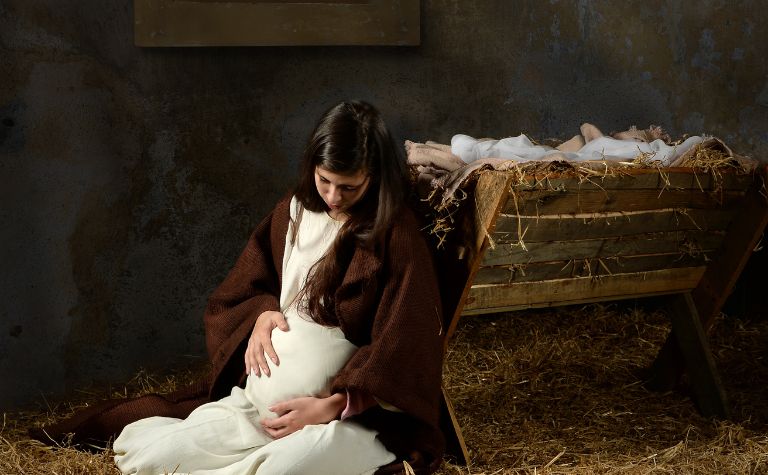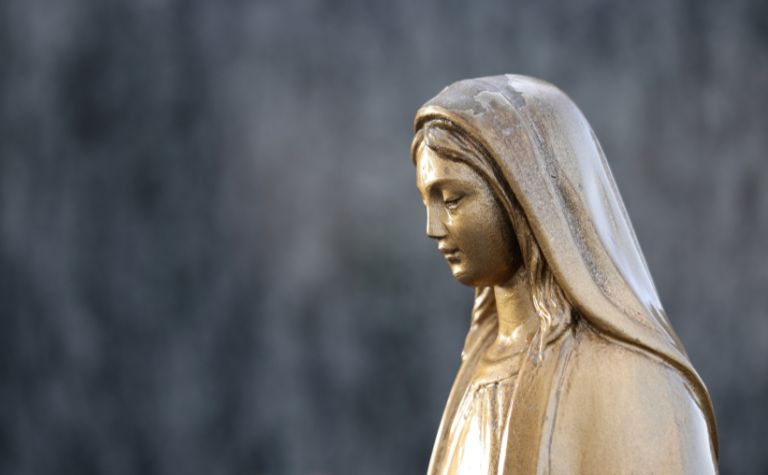The virgin Mary, the mother of Jesus, is one of the most fascinating people in the Bible. For 2,000 years, people of different eras and cultures have marveled at her faith in God. Mary’s story in the Gospels begins with her pregnancy, which was a miracle that evokes a lot of curiosity. One question many people ask is how old Mary was when she gave birth.
The Gospels don’t record Mary’s exact age at the time of Jesus’ birth. However, many Bible scholars believe she was a teenager. In the first century, girls as young as 12 years old could be betrothed to a man, which meant they would marry at 13. Mary may have been older, i.e. 14 to 15 years of age.
What details in Scripture hint at Mary’s approximate age? What was Jewish betrothal like in the first century? What are the arguments for speculating that Mary was 13 or 14 years old? What are the arguments for thinking she was 15 or 16? Keep reading to learn the answers to these questions and others.
Also see How Old Was Joseph When Jesus Was Born? to learn more.

What details in the Gospels hint at Mary’s approximate age?
Luke 1:27 gives readers a hint of Mary’s age. A key description in the verse is “virgin,” which comes from the Greek word parthenos. The term doesn’t pinpoint the exact age of a person, but it does refer to a narrow window of time during a young woman’s teenage years.
| Translation | Luke 1:27 |
|---|---|
| ESV | to a virgin betrothed to a man whose name was Joseph, of the house of David. And the virgin’s name was Mary. |
| KJV | To a virgin espoused to a man whose name was Joseph, of the house of David; and the virgin’s name was Mary. |
| NASB | to a virgin engaged to a man whose name was Joseph, of the descendants of David; and the virgin’s name was Mary. |
As reflected in the verses above, every major English translation of the Bible renders the Greek word parthenos as “virgin.” I. Howard Marshall, a prominent Luke scholar, writes that parthenos “means a young, unmarried girl, and carries the implication of virginity.” [1]
| Element | Parthenos |
|---|---|
| Basic meaning | a maiden who is a virgin |
| Greek word | παρθένος, ου, ὁ, ἡ |
| Pronunciation | parthenos |
In the Old Testament, Isaiah’s prophecy of the virgin birth supports this interpretation: “Therefore the Lord himself will give you a sign. Behold, the virgin shall conceive and bear a son, and shall call his name Immanuel” (ESV).
The Hebrew word translated “virgin” is almah and refers to a young woman who has never had sexual intercourse. The Septuagint, the Greek translation of the Old Testament that many New Testament authors read and quote from, uses the word parthenos (the same as Luke), which is translated “virgin.”
Luke 1:34 also confirms the meaning of parthenos in 1:27. When Mary is told that she is going to give birth, she responds, “How will this be since I am a virgin?” Luke doesn’t use the Greek word parthenos in 1:34. Instead, he uses a phrase describing what parthenos means.
This is reflected in translations like the New King James Version (NKJV): “Then Mary said to the angel, “How can this be, since I do not know a man?” Another translation reads, “How can this be, since I have not been intimate with a man?” (HCSB).
Also see Why Was Jesus Born In A Manger? to learn more.

What was Jewish betrothal like in the first century?
Luke 1:27 not only teaches that Mary was a virgin when she gave birth to Jesus, but that she was betrothed to Joseph. Not all English Bible translations include the word “betrothed,” as some render the word according to its full meaning — that she was pledged to be married.
| Translation | Luke 1:27 |
|---|---|
| ESV | to a virgin betrothed to a man whose name was Joseph, of the house of David. And the virgin’s name was Mary. |
| KJV | To a virgin espoused to a man whose name was Joseph, of the house of David; and the virgin’s name was Mary. |
| NASB | to a virgin engaged to a man whose name was Joseph, of the descendants of David; and the virgin’s name was Mary. |
| NIV | to a virgin pledged to be married to a man named Joseph, a descendant of David. The virgin’s name was Mary. |
In addition to 1:27, Luke also mentions Mary’s betrothal to Joseph in Luke 2:4-5: “And Joseph also went up from Galilee, from the town of Nazareth, to Judea, to the city of David, which is called Bethlehem, because he was of the house and lineage of David, to be registered with Mary, his betrothed, who was with child” (ESV).
Marshall explains: “Betrothal could take place as early as 12 years old and usually lasted for about a year. Although it was regarded as equally binding as marriage, the girl having the same legal position as a wife, it was not normal for intercourse to take place during this period.” [2] As to Mary’s exact age, Marshall adds, “We do not know how old Mary was.”
What was the purpose of betrothal?
The betrothal period had practical purposes. First, it allowed the bride and groom to get to know each other as first-century marriages were often arranged. Second, it allowed the families time to prepare for the couple’s wedding. Third, it allowed time to confirm the bride’s chastity, which reflected her commitment to her husband and their marriage.
Are there examples of betrothal in Scripture besides Mary and Joseph?
The Bible includes several betrothals including Lot’s daughters and their husbands (Gen. 19:8-14), Isaac and Rebekah (24:50-67), Jacob and Rachel (29:18-21), Samson and his Philistine wife (Judg. 14:1-20), and David and Michal (1 Sam. 18:27; 2 Sam. 3:14). Betrothal is also used figuratively in Scripture (e.g. Isa. 54:5; Hos. 2:19-20; Matt. 9:15; Eph. 5:25-27; Rev. 19:7; 21:9).
Also see How Old Was Jesus When He Started His Ministry? to learn more.

Was Mary 12 or 13 years old or more like 14 or 15 years old?
It’s important to know that the discussion below is largely speculative. It’s included in this article so readers are aware of the important points in the debate.
The most accurate answer to the question, “How old was Mary when she gave birth to Jesus?” is “the Bible doesn’t say.” Nevertheless, some think there is reason to believe Mary was an early teenager, while others suggest that she was probably in her midteens.
Virtually no scholars argue that she was 18 or older.
Was Mary 13 or 14 years old?
There is general agreement among scholars that a betrothal could occur as early as 12 years old and that it conventionally lasted one year. There is some historical evidence that when a young woman was betrothed at a later age, such as in her twenties, the betrothal period was reduced.
Catholic friar Paul Gaechter argues that Mary was probably betrothed between 12 and 13. “According to the customs of her time and country, Mary, at her betrothal with Joseph, was between twelve and twelve and one-half years old. The Mishna distinguishes the girl of minor age (kftanna) and the girl of major age (g’dula). On the girl of major age the first signs of maturity had already become visible.” [2]
This argument isn’t based on Old or New Testament teaching. The Mishna is a written record of Jewish oral law, which dates to approximately the early third century after Christ.
In contrast to this teaching, another rabbinical teaching from the same time period argues that betrothed young women should be fully grown and consent to the man her parents have chosen for her as a husband.
Also see Was Jesus Perfect? to learn more.
Was Mary 15 or 16 years old?
There is no historical evidence that suggests that most girls were betrothed at 12 in the first century. A family could betroth a daughter at 13, 14, 15, or 16, and still be in alignment with Jewish law and tradition.
In other biblical examples of betrothal (mentioned above), the women weren’t early teenagers, which means it was not abnormal for a family to dedicate their daughter to marriage at a later age.
Some readers also wonder if Mary was older than 13 or 14 because of the maturity she demonstrates in the passage. Mary’s faith, obedience, and perseverance suggest (though they don’t demand) that she is older than a young teenager. The manner in which she articulates her praise to God also reflects someone who is older.
Another consideration is an argument from silence. Modern medicine clearly teaches that pregnancy in a 13 or 14-year-old young woman has significant physical risks. Even 2,000 years later, pregnancy in the early teenage years can be an extremely difficult experience. The risk declines as a young woman’s body grows and matures.
Mary gave birth 2,000 years ago, and not in a hospital, but in a manger. Neither Luke nor Matthew gives any indication that Mary had complications during her delivery. This may suggest that her body was more physically mature than an average 13 or 14-year-old.
Also see Is Jesus Christ Coming Back Soon? to learn more.
References:
[1] The Gospel of Luke (NIGTC) by I. Howard Marshall. p. 64
[2] Paul Gaechter. Theological Studies, 2 no 2 May 1941, p 145-170
Related Articles
Joseph, the husband of Mary and the earthly father of Jesus Christ, is depicted in the Gospels as humble, law-abiding, and obedient. In many Christmas scenes, such as in displays of the manger, he is...
The name "Mary" appears many times in the New Testament and in some of its most significant stories. Readers encounter a woman named "Mary" in the Gospels, the book of Acts, and in one of Paul's...
